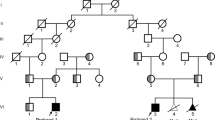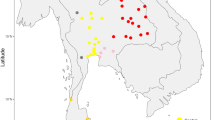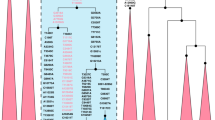Abstract
The quest for genes associated with diseases is widely recognized as an essential task in the effort to investigate the genetic basis of complex human disorders and traits. A basic stage in association studies is the careful choice of the model population, with preference to closed groups having little population substructure. Here, we show evidence for significant geographic substructure (P=0.017) of the maternal lineage represented by mitochondrial DNA variation in one of the most commonly studied populations, the Ashkenazi Jews. Most of the substructure effect stems from differential representation of haplogroups K and H. Our results underline the essentiality of adjusting data of population genetic variation for substructure during the design of association studies, even in apparently closed populations.
Similar content being viewed by others
Log in or create a free account to read this content
Gain free access to this article, as well as selected content from this journal and more on nature.com
or
References
Behar DM, Metspalu E, Kivisild T et al: The matrilineal ancestry of Ashkenazi Jewry: portrait of a recent founder event. Am J Hum Genet 2006; 78: 487–497.
Charrow J : Ashkenazi Jewish genetic disorders. Fam Cancer 2004; 3: 201–206.
Ostrer H : A genetic profile of contemporary Jewish populations. Nat Rev Genet 2001; 2: 891–898.
Service S, DeYoung J, Karayiorgou M et al: Magnitude and distribution of linkage disequilibrium in population isolates and implications for genome-wide association studies. Nat Genet 2006; 38: 556–560.
Shifman S, Bronstein M, Sternfeld M et al: A highly significant association between a COMT haplotype and schizophrenia. Am J Hum Genet 2002; 71: 1296–1302.
Risch N, Tang H, Katzenstein H, Ekstein J : Geographic distribution of disease mutations in the Ashkenazi Jewish population supports genetic drift over selection. Am J Hum Genet 2003; 72: 812–822.
Behar DM, Hammer MF, Garrigan D et al: MtDNA evidence for a genetic bottleneck in the early history of the Ashkenazi Jewish population. Eur J Hum Genet 2004; 12: 355–364.
Sokal RR, Rohlf FJ : Biometry: the Principles and Practice of Statistics in Biological Research. W.H. Freeman and Company: New York, 1995.
Thomas MG, Weale ME, Jones AL et al: Founding mothers of Jewish communities: geographically separated Jewish groups were independently founded by very few female ancestors. Am J Hum Genet 2002; 70: 1411–1420.
Malyarchuk BA, Grzybowski T, Derenko MV, Czarny J, Wozniak M, Miscicka-Sliwka D : Mitochondrial DNA variability in Poles and Russians. Ann Hum Genet 2002; 66: 261–283.
van der Walt JM, Nicodemus KK, Martin ER et al: Mitochondrial polymorphisms significantly reduce the risk of Parkinson disease. Am J Hum Genet 2003; 72: 804–811.
Helgason A, Yngvadottir B, Hrafnkelsson B, Gulcher J, Stefansson K : An Icelandic example of the impact of population structure on association studies. Nat Genet 2005; 37: 90–95.
Acknowledgements
This research project was supported by research grants from the Israel Science Foundation and the Israel Ministry of Health (D.M.), a fellowship from the Israel Ministry of Absorption (J.F.) and a grant from the Russell Berrie Foundation and D-Cure, Diabetes Care in Israel (B.G.).
Author information
Authors and Affiliations
Corresponding author
Rights and permissions
About this article
Cite this article
Feder, J., Ovadia, O., Glaser, B. et al. Ashkenazi Jewish mtDNA haplogroup distribution varies among distinct subpopulations: lessons of population substructure in a closed group. Eur J Hum Genet 15, 498–500 (2007). https://doi.org/10.1038/sj.ejhg.5201764
Received:
Revised:
Accepted:
Published:
Issue date:
DOI: https://doi.org/10.1038/sj.ejhg.5201764
Keywords
This article is cited by
-
Genetic and phylogeographic evidence for Jewish Holocaust victims at the Sobibór death camp
Genome Biology (2021)
-
A study of Kibbutzim in Israel reveals risk factors for cardiometabolic traits and subtle population structure
European Journal of Human Genetics (2018)
-
MtDNA meta-analysis reveals both phenotype specificity and allele heterogeneity: a model for differential association
Scientific Reports (2017)
-
Genetic affinities of the Jewish populations of India
Scientific Reports (2016)
-
mtDNA analysis of 174 Eurasian populations using a new iterative rank correlation method
Molecular Genetics and Genomics (2016)



